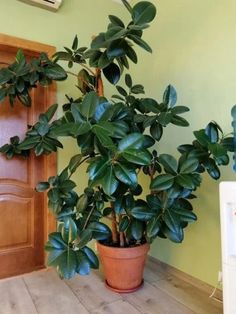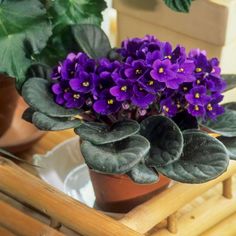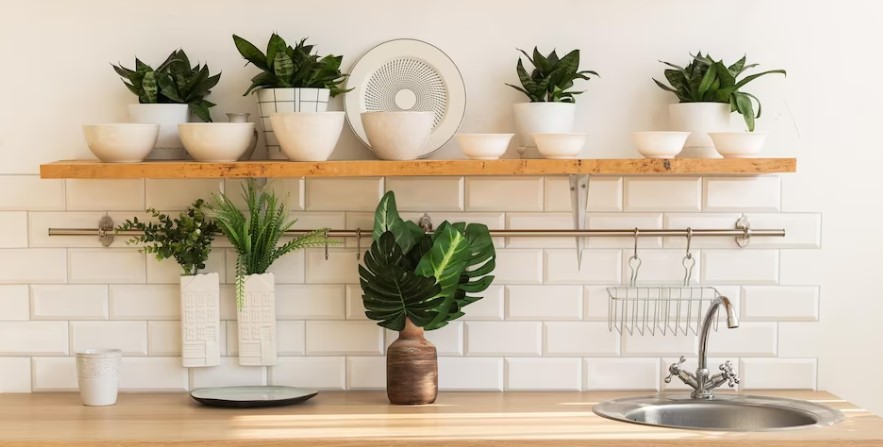Houseplants in the kitchen are a great way to bring natural beauty and freshness inside. They look nice and are useful too, since they clean the air and add some greenery to the heart of your home. This includes small veggies like basil and parsley as well as larger plants like aloe vera and spider plants. All of these can do well in the kitchen’s unique conditions.
If you take good care of your kitchen houseplants, they can not only make the room look better, but they can also help make it healthier and happy. We’ll talk about the best houseplants for the kitchen, what they do well, and how to take care of them so you can have a healthy indoor garden in this important room in your home.
Pothos (epipremnum Aureum)
Pothos, which is also called Epipremnum aureum, is a great plant for your home because it does well in low light and helps clean the air. Its trailing vines add a bit of greenery to the room and don’t need much care, which makes it a great houseplant for busy home cooks.
Epipremnum aureum, or pothos, is another name for this plant. It is a useful and popular choice for kitchen plants. Pothos plants have bright green leaves that look like hearts. They add a bit of natural beauty to any kitchen. This plant is easy to take care of and looks nice. It also has a lot of health benefits, which makes it a great choice for your home garden.
Benefits Of Pothos In The Kitchen:
- Air Purification: Pothos is a great air cleaner because it gets rid of harmful chemicals like formaldehyde and benzene that are often found in kitchens.
- Low Light Tolerance: Pothos does well in low light, which makes it great for kitchens that don’t get a lot of natural light.
- Easy Maintenance: This plant is hardy and doesn’t need much care, so it’s good for people who are busy or who are new to gardening.
- Versatility: Pothos can be grown in either water or soil, which gives you more display choices in the kitchen.
How To Care For Pothos In The Kitchen:
- Watering: Pothos likes dirt that is only slightly damp. Let the dirt dry out between waterings to avoid overwatering.
- Light: Even though pothos can handle low light, it will grow better and have more colorful leaves if you put it in indirect sunlight.
- Pruning: Regular trimming helps the plant keep its bushy look and promotes new growth.
Pothos (Epipremnum aureum) is a great choice for people who want a low-maintenance plant that looks good in their kitchen. Its ability to clean the air and adjust to different lighting conditions make it a useful addition to any kitchen. No matter how much you know about gardening or how new you are to it, pothos is a beautiful and useful plant that will do well in your kitchen.
Philodendron
Adding a touch of green to your kitchen is easy with philodendron plants. It is best to put these flowers in the kitchen because they do well in low light and can clean the air. Philodendrons are great for kitchens because they are easy to take care of and have pretty leaves.
Philodendron plants are often used as house plants because they don’t need much care and clean the air. Here is all the information you need to grow and take care of Philodendron plants.
Basic Care Tips
- Light: Philodendron plants do best in medium to low light, which makes them great for rooms inside that don’t get much sun.
- Watering: Before you water, let the top inch of dirt dry out. Too much watering can cause root rot, so it’s important to keep a regular watering plan.
- Soil: Philodendron plants do best in a peat-based soil mix that drains well.
- Temperature: They do best in temperatures between 18°C and 65°F (25°C to 78°C), and they can feel cold drafts.
- Fertilization: During the growing season, use a balanced liquid fertilizer every two to four weeks to help plants grow well.
Common Varieties
- Heartleaf Philodendron: The leaves on this type are heart-shaped, and it does well in hanging pots or on a trellis.
- Split-Leaf Philodendron: This type can be identified by its deeply cut leaves, which give any room a bit of tropical elegance.
- Brasil Philodendron: The Brasil Philodendron is a beautiful plant that would look great in any indoor yard because of its beautiful variegated leaves.
Propagation
Stem cuts are an easy way to make more philodendron plants. Take a look at this easy step-by-step guide to propagation:
- Select a Healthy Stem: Pick a stem that has a few leaves and at least two nodes.
- Trim and Root: Cut the stem off just below a node and put it in water or moist dirt until roots form.
- Transplanting: Once roots have grown, move the new Philodendron plant to a container with dirt that drains well.
Common Issues And Solutions
- Yellowing Leaves: This could be because it has too much water or too much strong sunlight. Change how often you water the plant and move it to a place with more light.
- Pests: Keep an eye out for aphids, spider mites, and other common plant pests that live inside. Check the leaves and twigs often for pests and treat them right away if you find any.
Final Thoughts
Philodendron plants are not only nice to look at, but they also make the air inside better. These plants can grow well and make any room look better if you give them the right care.
Herbs
Bright kitchen flowers will make your space look better. Adding herbs like mint, rosemary, and basil to your food not only makes it taste better, but they also clean the air naturally. You can enjoy having these green friends close by and bringing a touch of natural beauty to your home at the same time.
Kitchen herb plants are a great addition to any home because they give you easy access to fresh tastes and smells. Growing herbs in the kitchen can be very satisfying, no matter how much experience you have with gardening. Let us look at some of the herbs that do well in the kitchen flowers.
- Basil: Basil is a fragrant herb that is often used in Italian cooking. It does best in warm, sunny places with dirt that doesn’t stay soggy. Regular pruning supports bushy growth and makes the plant taste better.
- Parsley: Parsley is a very useful herb that can be added to many different recipes or used as a garnish. It likes soil that is moist and some sunshine. Trimming the plant often encourages new growth and keeps it from bolting.
- Rosemary: The herb rosemary is very hardy and has a strong, pine-like smell. It likes dirt that drains well and lots of sun. Regularly prune rosemary to keep its shape and encourage thick growth.
- Mint: Mint is a herb that grows quickly and makes both sweet and savory foods taste better and smell better. It does best in wet soil and needs to be watered often to keep from drying out.
Growing different kinds of herbs in your kitchen is a great way to make your food taste better and fill your home with nice smells. No matter if you have a sunny window sill or a small porch, you can grow herbs there.
Succulents
Find out why succulents are popular as houseplants in the kitchen. They are great for any kitchen because they are easy to clean and come in bright colors. Because succulents can grow in both wet and dry situations, they are a useful addition to any kitchen.
Because they look nice and don’t need much care, succulents are great for kitchen houseplants. These hardy plants do best in places with lots of sunlight and little watering, which makes them perfect for people who are busy or don’t have a green thumb.
Succulents are a great way to add some green to your kitchen because:
- Varied Selection: There are many different sizes, colors, and shapes of succulents, so you can make your kitchen look unique by adding plants that match your style and taste.
- Space-Saving: Succulents are great for small kitchens or countertops because they don’t take up much room. They can be put on windowsills, shelves, or small pots.
- Air Purification: For their ability to clean the air, succulents are often used in small rooms like kitchens to get rid of toxins and make the air quality better.
- Minimal Maintenance: Because their leaves can store water, succulents don’t need much watering and can handle being ignored for a while, which makes them a great addition to any kitchen.
Since succulents not only look nice in the kitchen but also make it healthier, they are a popular choice for flowers in the kitchen.
Spider Plant (chlorophytum)
Spider plant (Chlorophytum) is great for the kitchen because it doesn’t need much care and helps clean the air. Its gracefully arching leaves make it a charming piece of decor that improves the general mood of the kitchen.

People like spider plants, which are also called Chlorophytum, because they clean the air and are easy to take care of. This plant can be used in many ways and adds a bit of elegance to any kitchen. It also has many health benefits.
Benefits Of Spider Plants:
- Spider plants clean the air by getting rid of allergens and pollutants and letting oxygen out..
- These plants are easy to take care of, which makes them great for people who are new to gardening or don’t have much time to do it.
Care Tips For Spider Plants:
- • Because spider plants do best in indirect sunlight, they do well in kitchens that get a lot of natural light.
- Make sure the soil drains well, and water the plant when the top inch of earth is dry.
- You can help spider plant babies grow by putting them in water until their roots form and then moving them to new pots.
Common Issues With Spider Plants:
- Too much watering can cause root rot, so it’s important to keep a regular watering plan.
- Spider plants may not do well if they are in full sunlight for a long time because the leaves will get burned.
Decorating With Spider Plants:
- Spider plants can look beautiful in the kitchen if they are hung in macramé cases or set on high shelves.
- To make a show that looks good, you might want to mix different kinds of spider plants.
Snake Plant (dracaena Spp.)
The Snake Plant, or Dracaena spp., does well in the kitchen. It cleans the air and is easy to take care of, which makes it great for busy home cooks. With its beautiful straight leaves, this plant brings some green into any kitchen and helps keep things healthy.
Snake plants, which are also called Dracaena, are popular house plants because they are hardy and clean the air. The leaves of these plants are tall and sword-shaped, with beautiful patterns of different colors. The snake plant is not only beautiful, but it also has many health benefits that make it an essential for any home.
Benefits Of Snake Plants:
- Air Purification: People love snake plants because they clean the air of toxins, which makes them a great addition to any home. This plant cleans the air inside by taking in harmful chemicals and giving off oxygen. This makes the space better for you and your family.
- Low Maintenance: Snake plants don’t need much care; they only need a little watering and can grow well in a range of light conditions, even low light. This makes them perfect for people who are busy or don’t know much about farming.
- Aesthetically Pleasing: Snake plants add a bit of class to any kitchen with their striking, architectural look. Their different leaf designs and upright growth make them a nice addition to rooms inside.
- Feng Shui: Snake plants are thought to bring good energy into the home according to Feng Shui concepts. They also clean the air. It is said that putting one in the kitchen will increase the flow of good energy and make you feel calm and healthy.
Caring For Snake Plants:
- Light: Snake plants can survive in low light, but they do best in bright, indirect sunlight. Place them near a window to make sure they get enough light without being in full sunlight.
- Watering: Root rot can happen if you give snake plants too much water. Before you water, let the soil dry out. Only water when the top few inches of earth feel dry to the touch. During the winter, water less often to keep the dirt from getting too wet.
- Soil: Snake plants should be planted in dirt that drains well, like a mix of potting soil and perlite. Every two to three years, repot the plant to keep the dirt fresh and help it grow at its best.
- Temperature: Snake plants do best in temperatures between 60°F and 85°F (15°C and 29°C), but they can handle changing weather. Do not put them in drafts that are too hot or too cold; this can stress the plant.
Snake plants are a great addition to any indoor place because they bring some green to your kitchen and have many other uses as well.
Add a colorful snake plant to your kitchen to make it look better and enjoy the health and beauty benefits it brings to your home.
Rubber Tree (ficus Elastica)

The Rubber Tree (Ficus elastica) is a common garden plant that is known for its big, shiny leaves that can make any room feel more natural and greener. It’s easy to take care of, which makes it a great choice for people who want to add some plants to their kitchen.
The Rubber Tree, whose scientific name is Ficus elastica, is a famous houseplant loved for its pretty leaves and easy care. Let’s talk about why you need this plant in your home.
Benefits Of Rubber Tree In The Kitchen:
- Air Purification: Because Rubber Trees are good at cleaning the air, they are a great choice for the home, where good air quality is very important. They can get rid of toxins and make the air inside better.
- Low Maintenance: Rubber Trees are tough and don’t need much care. They do well in a range of light situations and don’t need to be watered very often. This makes them good for busy kitchens where plants may not get as much care.
- Ornamental Value: Rubber Trees add a touch of natural beauty to the kitchen with their shiny leaves and unique ways of growing, making it look better. They can be the center of attention or a nice addition to any kitchen design.
- Health Benefits: In addition to looking nice, Rubber Trees have been linked to mental health benefits. Their being in the kitchen can make it feel calmer and less stressful, which is good for your health as a whole.
Tips For Caring For Rubber Tree:
- Light: Avoid direct sunlight on your Rubber Tree because it can burn the leaves. Instead, put it somewhere bright but not directly in the sun.
- Watering: Do not water too much, as this can cause root rot. Let the dirt dry out between waterings. It’s important to pay attention to water splashes and humidity levels in the kitchen and change how often you water plants based on what you find.
- Temperature and Humidity: Rubber Trees do best in rooms with normal temps and levels of humidity. This makes them a good choice for most kitchens.
- Pruning and Maintenance: Occasionally remove any leaves that are yellow or damaged, and to keep the leaves clean and healthy, you might want to wipe them down with a wet cloth every so often.
With its ability to clean the air and low maintenance needs, the Rubber Tree is an obviously attractive addition to any kitchen. Whether you’re an experienced plant lover or a beginner, the Rubber Tree can easily improve the mood and health of your kitchen.
Coffee Plant (coffea Arabica)
The coffee plant, or Coffea arabica, is a famous kitchen houseplant that not only brings greenery into your home but also gives you coffee beans all the time. If you take good care of it, this plant can do well indoors, bringing a touch of nature to your kitchen and giving you the chance to pick your own coffee beans.
The Coffee Plant, whose scientific name is Coffea arabica, is often kept as a houseplant in kitchens because it has pretty leaves and can grow coffee beans.
Appearance And Growth
- The Coffee Plant is a plant that stays green all year. Its oval, glossy, dark green leaves are a deep green color.
- It usually gets to be 4 to 6 feet tall, which makes it a great addition to bigger kitchens.
- As the plant grows older, it may have small, sweet white flowers that turn into green fruits that turn red as they ripen.
Care And Maintenance
- The Coffee Plant does best in bright light that isn’t direct and mild humidity. It should be put next to or under a window.
- Make sure the dirt is always damp but not soaked, and feed it with fertilizer every two weeks during the growing season to help it grow.
- To make sure the plant grows well, it needs to be kept out of drafts and away from quick temperature changes.
A coffee plant in the kitchen not only adds some beauty, but it also gives you the chance to grow your own coffee beans, making it a lovely and useful addition to any kitchen.
Zz Plant (zamioculcas Zamiifolia
Want a plant for your kitchen that is easy to take care of? Take a look at the ZZ Plant (Zamioculcas zamiifolia). It does well in low light and doesn’t need much water, so it’s a great plant to have inside.
The ZZ Plant, which is also called Zamioculcas zamiifolia, is often used as a kitchen houseplant because it doesn’t need much care and cleans the air. This beautiful tropical plant brings some color and style to any kitchen. Let’s talk about why the ZZ Plant is a great addition to your kitchen.
Benefits Of Zz Plant
- Efficient air purifier: ZZ Plant is great at cleaning the air by getting rid of toxins and other pollutants. It’s a great thing to have in your kitchen to keep things healthy.
- Low maintenance: The ZZ Plant does well in low light and irregular feeding, which makes it a great choice for busy people or people who are new to gardening.
- Drought tolerant: Because ZZ Plant’s rhizomes can store water, it can survive periods of neglect. This makes it a great choice for people who forget to water their plants sometimes.
- Attractive foliage: The ZZ Plant’s shiny, dark green leaves add a touch of class to the kitchen and go with a lot of different types of decor.
Care Tips For Zz Plant
- Moderate watering: To avoid root rot and overwatering, ZZ Plant should only be watered a few times a week and let the soil dry out in between.
- Indirect light: Put the plant somewhere with partial sunlight so the leaves don’t get burned, but there is still enough light for it to grow.
- Well-draining soil: Use potting mix that drains well to make sure water gets to all the roots and doesn’t pool.
- Occasional fertilization: During the growing season, feed the ZZ Plant a balanced houseplant fertilizer to keep the leaves and stems healthy.
Potential Concerns With Zz Plant
- Toxicity: People can ingest ZZ Plant without getting sick, but pets can’t get to it, so keep it out of reach of kids and cats.
- Slow growth: The ZZ Plant grows slowly, so you’ll need to be patient while you wait for new leaves or the plant to grow.
- Allergen potential: Some people may get skin irritations from coming into close contact with ZZ Plant’s sap, so be careful when handling the plant.
In Summary
As well as making your kitchen look better, the ZZ Plant can also improve the air quality because it cleans the air and doesn’t need much care. Because it is tough and can grow in a variety of situations, it is a lovely and useful addition to any kitchen.
African Violet (saintpaulia Ionantha)

You can add some color to your kitchen with the African Violet (Saintpaulia ionantha), a houseplant that doesn’t need much care and has beautiful flowers. This small plant does best in bright, indirect light and is easy to grow in small areas, which makes it a great kitchen plant.
Because they are small and have tiny, bright flowers, African violets are a popular choice for people who like to garden indoors. These cute plants can do well in your kitchen with a little care. They will add a touch of natural beauty to the heart of your home.
Characteristics:
- The leaves of African violets are thick and dark green, and the flowers can be purple, white, pink, or other colors.
- Most of them are six to eight inches tall, which makes them good for small areas and displays on tables.
Care Tips:
- Give plants bright, indirect light to help them grow well. Keep the leaves from getting burned by direct sunlight.
- • Water the plant equally with water that is room temperature and make sure the soil stays moist but not soaked.
- • Keep the surroundings warm and humid by putting the plant on a tray filled with pebbles and water to raise the humidity around it.
Propagation:
- To grow more African violets, take leaf or stem cuttings and make sure each one has a healthy part of the plant on it. Then, put the cuttings in soil that drains well to help the roots grow.
Troubleshooting:
- • If the leaves start to curl or change color, it could mean that they are getting too much water or not enough light. Change how often and where you water to fix the problem.
- When you water the plant, don’t get the leaves wet. This will keep the flowers from getting botrytis.
Putting an African violet in your kitchen not only adds a touch of nature that you’ll enjoy, but it can also be a relaxing hobby that will make your daily life more beautiful and joyful.
Frequently Asked Questions For Kitchen Houseplants
What Are The Best Kitchen Houseplants For Beginners?
For first-time gardeners, herbs like basil, mint, and parsley, as well as low-care plants like aloe vera and spider plants, are the best kitchen flowers. These plants do well in kitchens and are simple to take care of, which makes them great for people who are new to gardening indoors.
How Can I Ensure My Kitchen Houseplants Get Enough Light?
If you want to make sure your kitchen flowers get enough light, put them near a south-facing window that gets light all day. If they don’t get enough natural light, you might want to use grow lights to meet their light needs and help them grow.
What Are The Benefits Of Having Houseplants In The Kitchen?
Having houseplants in the kitchen can help clean the air, make the room look a little more natural, and give you fresh veggies for cooking. Plants like aloe vera can also be used to treat small cuts and burns, which makes them useful to have in the home.
How Often Should I Water My Kitchen Houseplants?
How often you water kitchen houseplants varies on things like the type of plant, the size of the pot, and the weather. Usually, you should water when the top inch of dirt feels dry to the touch. Root rot can happen if you water too much.
Conclusion
Adding flowers to your kitchen can make the space look better and the air quality better. You can easily find a plant that fits your needs and looks good because there are so many to choose from. Houseplants not only make the kitchen look nicer and more alive, but they are also good for you in many ways.
Start adding these natural touches to your food to make it better.










Leave a Review